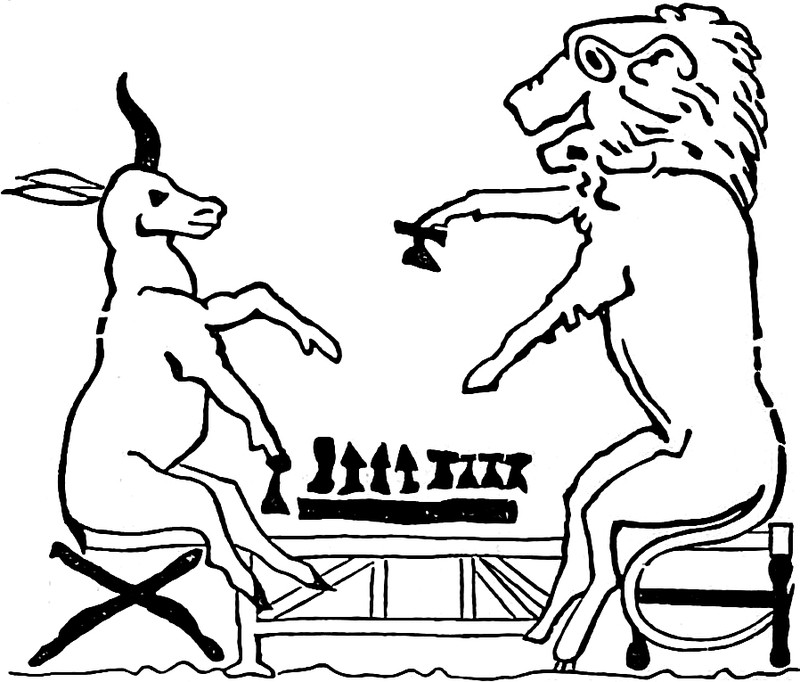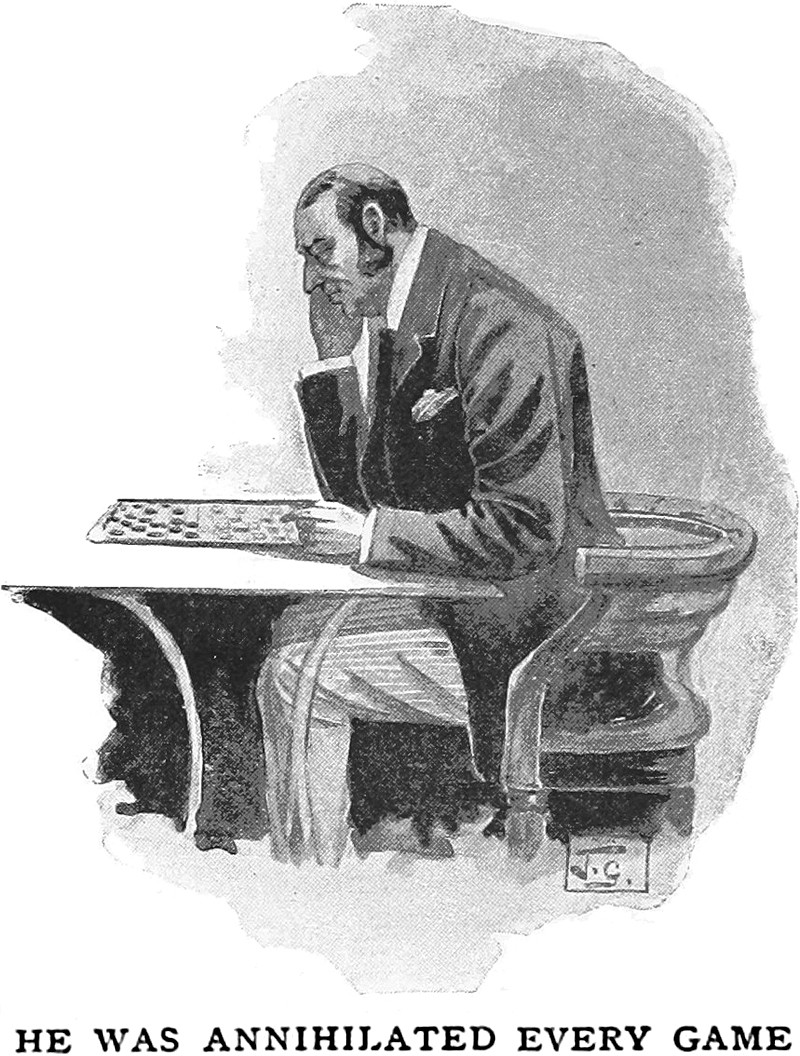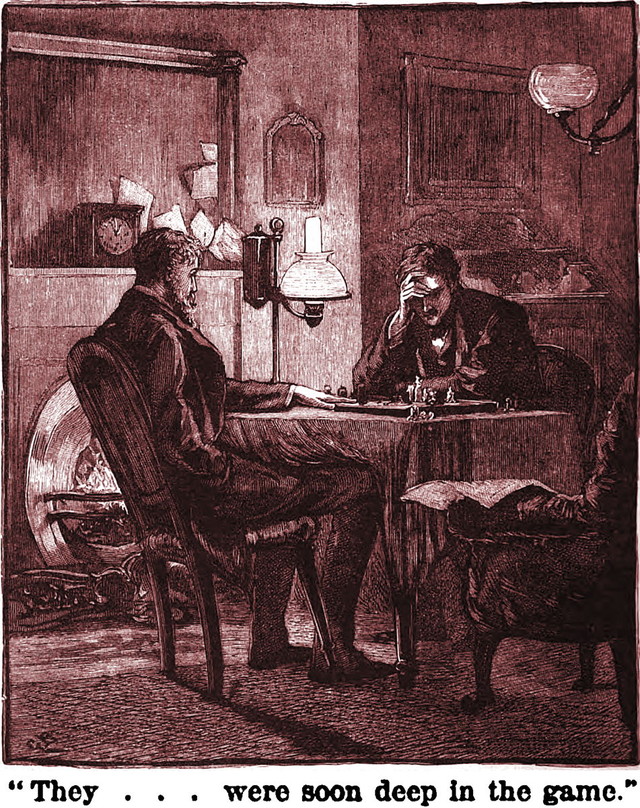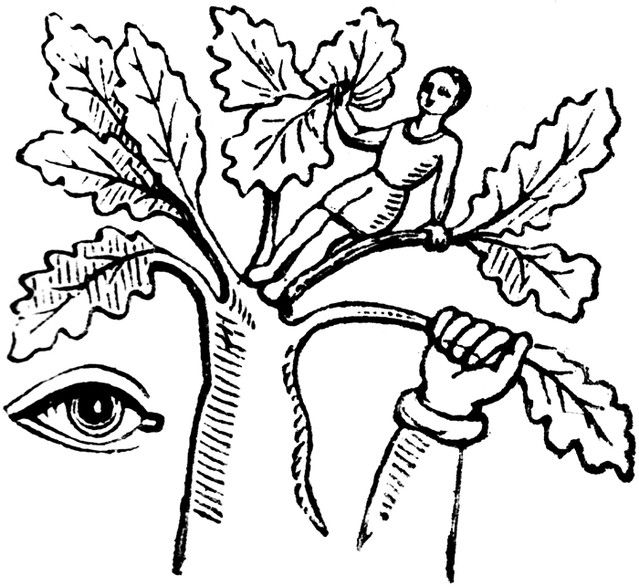

 |
|
|
 |
 |
 |
David Levin has said that "The real contest is how we play against ourselves. There's always that other side of each of us, pulling us down." The caption of our illustration reads, "He was annihilated every game." It's from A Ramble Round the Globe by Baron Dewar, 1894.
|


 |
|
|
 |
 |
 |
"Watching the skittle players," from In the Ardennes by Katharine Sarah Macquoid, 1881.
Interestingly, we sent this image to a games aficionado, but he wasn't convinced that the pig was truly spectating skittles players. He felt that the pig's expression was inscrutable, and the so-called skittle players are out-of-frame. Yet the caption tells us what we're seeing; "case closed" as far as we're concerned. To paraphrase René Magritte, this is not a pig, anyway. If we can't roll with it, we'll never knock down any pins. |





 |
|
|
 |
 |
 |
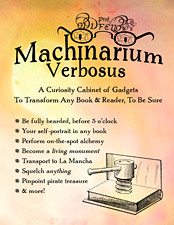
Jollification expert Bernie DeKoven highlights our oddest work yet — a book that transforms other books in surprising ways. As we confabulated with Bernie: The Dictionary Game (see also Fictionary) turns a serious reference book into a gaming generator; the dictionary is playfully transformed from a tool for decoding puzzling words into a puzzle-making machine, where whimsically fake definitions take the stage. But could any book, spontaneously pulled off the shelf, be transformed into a playfulness machine? Could one’s entire home library be a gaming center? That’s the lofty goal of a new publication that offers, among other oddities, cut-out paper spectacles for seeing more than is readily apparent in any book.
Please note that our Machinarium Verbosus is a book for the few—the very few. If it’s important to one’s psychological well-being that the machinations of the Universe be neat and
tidy and wholly comprehensible by the human mind, then absolutely do not proceed with
this book’s experiments. Let this constitute a very serious warning: do not take these experiments
lightly, as any one of them may induce an existential crisis. |


 |
|
|
 |
 |
 |
(The following is our Guest Blog post for DeepFun.com)
The classic hand game of Rock-Paper-Scissors has a shadow side — quite literally. It’s played partially in the dark. Each move casts shadows on the wall. And the rules are reversed to whimsical results. Requirements: - a blank wall – a canvas for shadow-casting
- a lamp easily turned off and on (the sole illumination in the room)
- two handy players
- one scorekeeper/storyteller (scorekeeping is optional, a player may act as scorekeeper, especially if the lamp has a foot-operated switch)
- spectators (occupancy not to exceed fire marshall’s restrictions, of course) (also optional)
When the scorekeeper initiates darkness, each player opaquely forms one of three hand gestures in front of the lamp. At the count of three, the scorekeeper lets there be light, and the gesticulative shadows are writ large on the wall. The so-called Rock is actually a Paperweight. The so-called Paper is actually a Paper Doll (a butterfly, a bunny, a goat, or any other hand shadow figure the player desires) The so-called Scissors are still cutting blades, but let’s call them Snippers just to be different.
Traditional Game
| Shadow Game
| Paper covers the Rock
| Paperweight sensibly covers the Paper Doll and the Paperweight wins.
| Scissors cut the Paper
| Paper Doll is born of the Snippers and the Paper Doll wins.
| Rock crushes the Scissors
| Paperweight *sharpens* the Snippers and the Snippers win.
|
As a mnemonic, Snippers *need* to be sharp in order to fulfill their destiny, Paper Dolls *need* to be snipped in order to take shape and fulfill their destiny, and Paperweights *need* to rest upon Paper Dolls because everyone requires downtime to flatten out, relax, and recharge so as to fulfill their destinies. There are three possible ties. In the traditional game, these are simply ignored. In the Shadow Game, these are celebrated as follows:
Both players throw
| Both players act out
| Paperweight
| Shadow boxing
| Snippers
| Running with scissors
| Paper Doll
| The scorekeeper becomes a storyteller when two Paper Dolls grace the wall and interact as a shadow-puppetshow ensues
|

|




 |
|
|
 |
 |
 |
Here's a game of "What am I?" Your clues: - I am an arrogant slap in the face from across the room.
- I am an ethereal corset trapping everyone in the same unnatural shape.
- I am a lazy and inelegant concession to fashionable ego.
- I am too often a substitute for true allure and style.
- I am an opaque shell concealing everything—revealing nothing.
- I am a childish masque hiding the timid and unimaginative.
What am I? Answer: Perfume (The answer is in black text on the black background. Highlight it to view.) These clues are courtesy of Christopher Brosius. |

 |
|
|
 |
 |
 |
Here's one of Nabokov's methods for a secret code. Note the charming detail that " one-letter words remain undisguised": For their correspondence in the first period of separation, Van and Ada had invented a code ... One-letter words remained undisguised. In any longer word each letter was replaced by the one succeeding it in the alphabet at such an ordinal point–second, third, fourth, and so forth–which corresponded to the number of letters in that word. Thus "love", a four-letter word, became "pszi" ("p" being the fourth letter after "l" in the alphabetic series, "s" the fourth after "o" et cetera), whilst, say, "lovely" (in which the longer stretch made it necessary, in two instances, to resume the alphabet after exhausting it) became "ruBkrE", where the letters overflowing into the new alphabetic series were capitalized. —V. Nabokov, Ada or Ardor: A Family ChronicleVia Gretel und Hänsel |

 |
|
|
 |
 |
 |
Going through some old files, we rediscovered our rough notes for a card game we devised several years ago. Suggestions for improvements are welcome.
---
Elements is a card game for 2 players that involves sketching a map throughout. The object of the game is to win all the cards. At the end, both players will have created their own map of a new world they have created out of combined elements.
Required materials: deck of element cards, two pieces of blank paper, pencils (or crayons, markers, and so on).
The cards are divided into 7 suits (earth, air, space, fire, water, metal, wood), according to the sacred elements recognized in ancient belief systems from around the world. Each element card is numbered from 1 to 10. Higher numbers indicate stronger forces (i.e. influences, powers) associated with that element, and lower numbers indicate weaker forces.
Shuffle the deck. Deal out all the cards, so that each player has half of the deck. Players do not look at their cards, but keep them in a stack face down.
Players simultaneously turn their top cards face up and put them on the table. Whoever turns the higher card takes both cards, determines the cards' outcome according to the key below, adds the cards to his own discard pile, and quickly sketches the outcome to his map. Then both players turn up their next card and so on.
If the turned up cards are equal, there is a stalemate and each player adds his own card to his own stalemate pile.
The game continues until one player has the majority of cards in his discard pile and wins. However, both players will end up with a map of a new world.
Regarding the map, it is recommended that each player begin by dividing the blank page into three equal sections with three horizontal lines. The upper section will represent the Upper World or sky, the middle section will represent the Middle World or land, and the lower section will represent the Underworld or underground.
Key:
earth / earth (stalemate)
earth / air mountaintop
earth / space cavern
earth / fire crystal formations
earth / water mudslide
earth / metal buried treasure
earth / wood planted seed
air / earth dust cloud
air / air (stalemate)
air / space gusting wind
air / fire hot air balloon
air / water cloud
air / metal windmill
air / wood fallen tree
space / earth moon
space / air tornado
space / space (stalemate)
space / fire shooting star
space / water rainbow
space / metal asteroid
space / wood hollow tree
fire / earth volcano
fire / air fireball
fire / space aurora
fire / fire (stalemate)
fire / water steam plume
fire / metal forge
fire / wood smoldering ashes
water / earth ocean
water / air rainstorm
water / space underwater grotto
water / fire geyser
water / water (stalemate)
water / metal wishing well
water / wood shipwreck
metal / earth bridge
metal / air airplane
metal / space meteor
metal / fire torch
metal / water chalice
metal / metal (stalemate)
metal / wood axe
wood / earth forest
wood / air tall tree
wood / space crate
wood / fire sacrificial pyre
wood / water reeds
wood / metal vine-covered statue
wood / wood (stalemate)
|


 |
|
|
 |
 |
 |
 A Can of Yams or a Can of Sweet Potatoes?How well do you know your tubers? In each sentence, guess whether the can of ___ contains yams or sweet potatoes. A Can of Yams or a Can of Sweet Potatoes?How well do you know your tubers? In each sentence, guess whether the can of ___ contains yams or sweet potatoes.1. "Her eyes stopped at the single can of ___. That one insignificant can, Katie knew, was her downfall." — Donna Nelson, Encore, 2004, p. 173 2. "One itsy-bitsy can of ___ won't do it, will it, Sammy boy?" — Jamie L. Turner, By the Light of a Thousand Stars, 1999. p. 179 3. "They can take a chance on a can of ___ and enjoy a surprise." — Thomas Swann Harding, The Popular Practice of Fraud, 1935, p. 313 4. "Cash gain in April is linked to an incident involving a can of ___ and a finger." —Horoscope, The Weekly World News, March 15, 2004 5. "Destiny lies in a can of ___ in syrup." —Horoscope, The Weekly World News, Nov. 15, 2004 6. "People like that, they got to deserve a can of ___ up the ass." — Joe R. Lansdale, A Fist Full of Stories, 1996, p. 133 Answers: 1. sweet potatoes, 2. sweet potatoes, 3. sweet potatoes, 4. yams, 5. yams, 6. yams. (The answers are in black text on the black background. Highlight to view.) (This puzzle is inspired by and dedicated to Jonathan-Caws Elwitt, author of The Can of Yams.)
|

Page 26 of 28

> Older Entries...

Original Content Copyright © 2025 by Craig Conley. All rights reserved.
|




